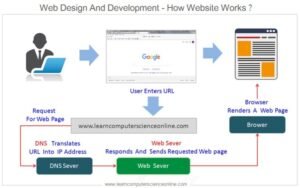Introduction.
Website work: In today’s digital landscape, a website is often the first point of contact between a business and its customers. However, website performance issues—such as slow loading times, broken links, or poor user experience—can drive visitors away, harm search engine rankings, and erode brand credibility. Studies show that 53% of mobile users abandon sites that take over 3 seconds to load (Google, 2020), and a single broken link can disrupt user trust and conversions. These issues, if left unaddressed, can lead to significant revenue loss and missed opportunities. This guide provides a clear, actionable framework to diagnose and resolve website performance issues, ensuring your site is fast, functional, and user-friendly. By breaking down the problem, identifying causes, and offering step-by-step solutions, we’ll empower you to optimize your website and prevent future issues, with real-world examples to illustrate proven strategies.
Comprehensive Guide to Resolving Website Performance Issues.
Website performance issues, such as slow loading times, broken links, or poor user experience, can significantly impact a business’s online presence. This guide breaks down the problem, identifies causes, outlines consequences, and provides actionable steps to resolve these issues. Real-world examples and prevention tips are included to ensure long-term success.
Breaking Down Website Performance Issues.
Website performance issues can be categorized into three main components:
-
Slow Loading Times: Pages take too long to load, causing user frustration.
-
Broken Links and Errors: Links that lead to 404 errors or other technical glitches.
-
Poor User Experience (UX): Unintuitive navigation, unresponsive design, or cluttered interfaces.
Common Causes.
-
Slow Loading Times:
-
Large, unoptimized images or videos.
-
Excessive HTTP requests or unminified code (CSS, JavaScript).
-
Inadequate hosting or server performance.
-
Unoptimized databases or excessive plugins.
-
-
Broken Links and Errors:
-
Outdated or incorrect URLs after site migrations or updates.
-
Missing or deleted resources (e.g., images, scripts).
-
Misconfigured redirects or server settings.
-
-
Poor User Experience:
-
Non-responsive design (not mobile-friendly).
-
Cluttered layouts or confusing navigation.
-
Slow interactions due to heavy scripts or poor coding practices.
-
Consequences of Inaction.
Failing to address website performance issues can lead to:
-
Lost Revenue: Studies show that a 1-second delay in page load time can reduce conversions by 7% (Source: Akamai, 2017).
-
Poor SEO Rankings: Google prioritizes fast, user-friendly websites, and slow or broken sites rank lower.
-
User Frustration: 53% of mobile users abandon sites that take over 3 seconds to load (Source: Google, 2020).
-
Brand Damage: A poor website experience erodes trust and credibility.
Actionable Steps to Resolve Website Performance Issues.
Step 1: Diagnose the Problem.
-
Tools: Use Google PageSpeed Insights, GTmetrix, or Pingdom to analyze site speed and identify bottlenecks. For broken links, use Screaming Frog SEO Spider or Broken Link Checker.
-
Action: Run a performance audit to pinpoint slow-loading elements, broken links, or UX issues. Note metrics like Time to First Byte (TTFB), First Contentful Paint (FCP), and Total Blocking Time (TBT).
-
Example: A retail website used GTmetrix and found that unoptimized images caused a 5-second load time.
Step 2: Optimize Page Speed.
-
Image Optimization:
-
Compress images using tools like TinyPNG or ImageOptim.
-
Use modern formats like WebP for smaller file sizes.
-
Implement lazy loading to defer off-screen images.
-
-
Code Optimization:
-
Minify CSS, JavaScript, and HTML using tools like UglifyJS or CSSNano.
-
Reduce HTTP requests by combining files or using CSS sprites.
-
-
Server and Hosting:
-
Upgrade to a faster hosting provider (e.g., SiteGround, WP Engine).
-
Enable caching with plugins like W3 Total Cache (WordPress) or server-side solutions like Varnish.
-
Use a Content Delivery Network (CDN) like Cloudflare to reduce latency.
-
-
Example: The retail website compressed images, reducing load time to 2 seconds, and implemented Cloudflare, improving TTFB by 30%.
Step 3: Fix Broken Links and Errors.
-
Identify Broken Links:
-
Use Screaming Frog to crawl the site and list all 404 errors or broken resources.
-
-
Resolve Errors:
-
Update URLs in the CMS or database after migrations.
-
Set up 301 redirects for outdated URLs using .htaccess (Apache) or Nginx configurations.
-
Replace missing resources or remove references to them.
-
-
Example: A blog site migrated to a new CMS and found 50 broken links using Screaming Frog. They set up 301 redirects, restoring functionality.
Step 4: Enhance User Experience.

-
Responsive Design:
-
Use frameworks like Bootstrap or Tailwind CSS to ensure mobile compatibility.
-
Test responsiveness with BrowserStack or Google’s Mobile-Friendly Test.
-
-
Navigation and Layout:
-
Simplify menus to 5–7 items, following UX best practices.
-
Use clear calls-to-action (CTAs) and avoid clutter.
-
-
Interactive Elements:
-
Optimize JavaScript to reduce interaction delays.
-
Test forms and buttons for functionality across devices.
-
-
Example: An e-commerce site redesigned its navigation, reducing bounce rates by 15% after user testing revealed confusing menus.
Step 5: Test and Monitor.
-
Testing:
-
Run post-optimization tests with Google PageSpeed Insights or GTmetrix to confirm improvements.
-
Conduct user testing with tools like Hotjar to observe real user behavior.
-
-
Monitoring:
-
Set up Google Search Console to monitor for crawl errors or UX issues.
-
Use uptime monitoring tools like UptimeRobot to ensure server reliability.
-
-
Example: The retail site implemented Hotjar, identifying a checkout form issue that, once fixed, increased conversions by 10%.
Real-World Case Study.
Case Study: Small Business E-Commerce SiteA small business selling handmade goods faced slow load times (6 seconds), broken product links, and a high mobile bounce rate (65%). Using GTmetrix, they identified large images and excessive plugins as culprits. They:
-
Compressed images with TinyPNG, saving 2MB per page.
-
Removed unused WordPress plugins, reducing HTTP requests by 20%.
-
Fixed 30 broken links with 301 redirects using Yoast SEO.
-
Redesigned the mobile checkout process with Tailwind CSS. Results: Load time dropped to 2.5 seconds, mobile bounce rate fell to 40%, and conversions increased by 12% within a month.
Prevention Tips.
-
Regular Audits: Schedule monthly performance checks with GTmetrix or Google Search Console.
-
Optimize Early: Compress images and minify code before launching new pages.
-
Choose Reliable Hosting: Invest in quality hosting with SSD storage and CDN support.
-
Update CMS and Plugins: Keep WordPress, Shopify, or other platforms updated to avoid compatibility issues.
-
User Feedback: Use surveys or tools like Hotjar to catch UX issues early.
Next Steps and Call to Action.
-
Run a Diagnostic: Use Google PageSpeed Insights or GTmetrix today to identify your site’s performance issues.
-
Prioritize Fixes: Start with high-impact issues like image optimization or broken links.
-
Hire Experts if Needed: If the issues are complex, consult a web developer or SEO specialist via platforms like Upwork or xAI’s API services (https://x.ai/api) for custom solutions.
-
Monitor Progress: Set up Google Search Console and schedule regular audits.
Act Now: A fast, functional website is critical to retaining customers and boosting revenue. Don’t let performance issues harm your business—start optimizing today!
